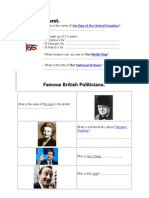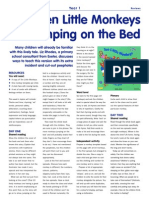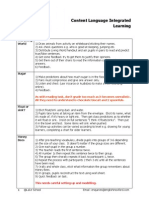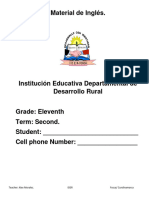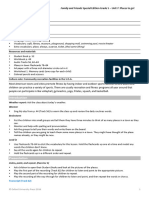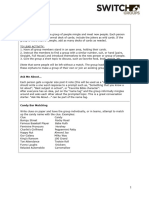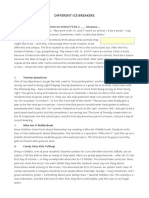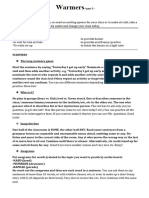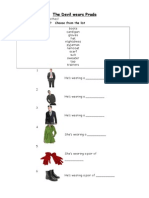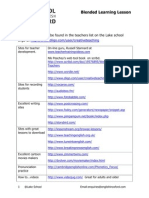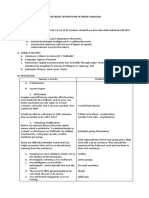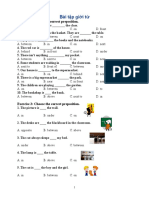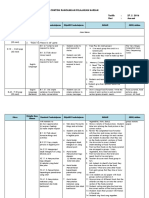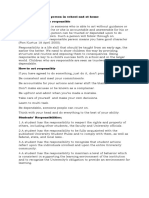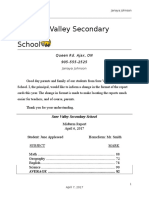Communication in The Classroom - CTPC
Communication in The Classroom - CTPC
Uploaded by
lakeschoolCopyright:
Communication in The Classroom - CTPC
Communication in The Classroom - CTPC
Uploaded by
lakeschoolOriginal Title
Copyright
Share this document
Did you find this document useful?
Is this content inappropriate?
Copyright:
Communication in The Classroom - CTPC
Communication in The Classroom - CTPC
Uploaded by
lakeschoolCopyright:
Communication in the Classroom
Taking photographs
1) Divide the pupils into groups according to the number of people in the portrait. Plus, each group needs two photographers. 2) The photographers have to get their group into the same position as the family in the portrait. They can only give instructions; they cannot touch the group members. 3) Say cheese, pretend to take a photo. 1) Show 1st picture e.g. fish. Elicit fish from group. Model I like fish and stick the picture on one side of the board. Repeat with all pictures, modelling the language of I like. Or I dont like. and building up 2 sets of pictures on the board. 2) Remove all the pictures from the board. Show the pizza picture and elicit pizza from the children. Then go through the pictures again modelling I like onions on my pizza or I dont like fish on my pizza. Again, you can make two groups on the board or physically stick the pictures of the things you like on a blank pizza circle. 3) Drill the target language. Positive / negative statements. 4) Elicit the question form and answer. 5) Drill whole class then do half class drills with 1 half of the class asking the question and the other half answering. 6) Give out blank pizzas. Pupils choose 3-4 toppings from the board and draw them on their pizza. 7) Pupils do a mill drill around the room practising their questions and answers. The aim of the activity is to find people with the same pizza. 8) Follow-up, Top Toppings (a class survey and bar chart). 1) Divide the pupils into groups of about 6-8. Give each person in the group a different picture. (You can use the same set of 6-8 pictures for each group). 2) Explain that everyone in the group has a new friend (as seen in the picture) and they are going to write down some information about these people. 3) Ask the pupils to write down the name of their new friend on the paper. You Model. Then they pass their paper to the person on their left. This time they must add the age of the friend to the paper. This continues around the circle until it reaches the beginning. Information to include: name, age, nationality, brothers or sisters, pet, favourite colour, something theyre good at, favourite pop star, favourite food, worst food, secret, ambition etc. 4) The pupils should each have a profile of their new friend who they introduce to their partner/group. 5) Feedback. This profile of a friend could be used as a spring board for writing activities. A movie could be made about the new friend. Elicit further ideas.
Pizza
My new friend
Which dinosaur?
1) Divide the pupils into pairs. They need one piece of paper and a pen between them. 2) This is a paired dictation activity. One person is going to be the writer and the other the reader, then half way through the activity they will change over. 3) Check everyone knows full stop, capital letter and comma. 4) Each pair chooses a dictation card but doesnt look at it yet. 5) When everyone is ready the dictation can begin. Shout change when they are half way through. This comes quite quickly as the texts are short. 6) When they have finished they check their writing against the original for any errors. Every time there is a mistake they deduct a point from their starting score of 100. This way, even if they do badly they still have a high score (psychologically this is motivating). 7) Collect the dictation cards. Pairs then take their text around the room to find the picture of the dinosaur that it matches. 8) Check. Which words tell you that is your dinosaur? 9) Follow-up. Give children a new picture from a set e.g. 1) Tell the story. 2) Tell the story again, this time the pupils fill in a diary with the monkeys activities. They can draw or write the activity. 3) Check. What is Mr Monkey doing on Wednesday? Who is he visiting 4) Pupils then fill in their own blank diary with 5 activities. Then they choose one day to have a party and put that in their diary too. 5) Pupils then mill around room trying to find people who are free to come to their party. Are you free on Thursday? No, on Thursday Im playing tennis. When they find someone who is free they write their name in their diary. 1) Tell the story. 2) Use it to practise prepositions and play a preposition game hide and seek game. 1) Draw 3 battleships of three squares long. They can go horizontally/vertically. 2) Pairs have to find their partners ships by asking questions according to the grid lines. E.g. Did Prince William star in Harry Potter? If it is a hit they answer yes, if it is a miss they answer no. 1) Divide the participants into 5 groups. Elicit the five senses and write each one on a piece of A4 paper. Give a sense to each of the 5 groups. 2) Set a topic e.g. at the beach, at school, at the park. 3) Groups then brainstorm words for things they can see, hear, smell, touch and taste. 4) Feedback answers the board. 5) Pupils then draw a picture of the set topic. They have to choose e.g. 8 things from the board to draw in their pictures. They must not show their partner. 6) Then, they take it in turns to dictate their pictures. 7) Each pair chooses the best picture to enter into a class competition. They have to choose the two most similar pictures. 8) Display the pictures around the room and give each person a gold star. They have to stick their star on the best pair of pictures.
The monkey & the crocodile
Wheres Spot?
Battleships
Sense dictation pictures
Instructions machine
1) Cut and colour the machine. 2) Write the instructions whole class. Put one open question in each corner. E.g. How old are you? Whats your favourite colour? Whats your name? 3) Write an instruction in each of the 8 triangles next to the colours. Brainstorm a few on the board e.g. Sing a song, jump 5 times, move like a monkey, say 5 weather words. Encourage them to write at least 4 instructions that produce an oral response. 4) Now do the folding bit. 5) Once made they have to test their instruction machines on their partners, limit the task to say 3 turns each. 1) Chant I saw the Queen the other day She said, how many English words can you say? I saw superman the other day He said, how many colour words can you say? The children chant with the teacher then they call out as many words as possible. The teacher keeps count. Repeat the activity in a few weeks and see if the class can beat their previous score.
Superhero brainstorm
Information gaps
Biographies Choose a famous person or popular fictional character. Write a short information rich text about them. Make 2 copies of the text then carefully remove different key pieces of information from the A and B texts. Or, get pupils to create their own texts which they can then make into a gap fill for another person/pair in the class. Crosswords Find a word puzzle or crossword in your coursebook and turn it into an information gap. Copy the original twice then make your A and B puzzles by removing clues/pictures etc. from each one. Now you have a more motivating and communicative task. Pictures You can also do the same with pictures. We commonly call this Spot the Difference!
Communication in the Classroom - Battleships
You
fly aeroplanes bananas work in schools grow on trees grow
underground
live in nests
live in water
birds
teachers
potatoes
pilots
fish
Your partner
Miss!
bananas
fly aeroplanes
work in schools
grow on trees
grow underground
live in nests
live in water
Hit!
birds
teachers
potatoes
Sunk! !
pilots
fish
Daniel Radcliffe His Life Story
Daniel (1) _____ Radcliffe was born on 23 July 1989, in (2) ____________ , England. He is an only child. Radcliffe's father is from Northern Ireland and his mother was born in South Africa but raised in England. Daniel's parents were both actors as children and now work in (3) __________________ , but they tried to keep Daniel out of acting to have a normal childhood for as long as possible. Radcliffe, however, wanted to act at the age of five, and in December 1999, aged ten, he made his acting debut in the BBC television adaptation of the Charles Dickens novel David Copperfield. Radcliffe was educated at independent schools for boys in London, but following the release of the first Harry Potter movie, attending school became difficult. At age(4) ____________ he was cast as the title character in the first Harry Potter film, and starred in the series for ten years until the release of the eighth and final film in July 2011. In 2007 he also began starring in London and (5) ____________ theatre productions. In 2008, Radcliffe revealed that he suffers from a mild form of dyspraxia. The motor skill disorder sometimes gets so bad that he has trouble doing simple activities, such as (6) ____________ ___________________ . Radcliffe works for many charities, including Demelza House Children's Hospice and The Trevor Project and in 2011, he was awarded the Trevor Project's "Hero Award".
1. What _____________ Daniel's middle name? 2. Where _________________________________________ ?
3. do/what/his/do/parents/his ? ______________________________ 4. How old______________________________________________________ ? 5. Where ______________________________________________________ ? 6. _______________________________________________________________ ?
Daniel Radcliffe His Life Story
Daniel Jacob Radcliffe was born on (1) ____________ , in West London, England. He (2) ________________________ . Radcliffe's father is from Northern Ireland and his mother was born in (3) ____________ but raised in England. Daniel's parents were both actors as children and work in the film industry, but they tried to keep Daniel out of acting to have a normal childhood for as long as possible. Radcliffe, however, wanted to act at the age of five, and in December 1999, aged (4) ____________ , he made his acting debut in the BBC television adaptation of the Charles Dickens novel David Copperfield. Radcliffe was educated at independent schools for boys in London, but following the release of the first Harry Potter movie, attending school became difficult. At age 11 he was cast as the title character in the first Harry Potter film, and starred in the series for (5) ____________ years until the release of the eighth and final film in July 2011. In 2007 he also began starring in London and New York theatre productions. In 2008, Radcliffe revealed that he suffers from a mild form of (6) ____________ . The motor skill disorder sometimes gets so bad that he has trouble doing simple activities, such as writing or tying his own shoelaces. Radcliffe works for many charities, including Demelza House Children's Hospice and The Trevor Project and in 2011, he was awarded the Trevor Project's "Hero Award".
1. __________________________________________ ? 2. many/how/sisters/got/and/he/brothers/has ? ______________________________ 3. Where ____________________________________ ? 4. How old______________________________________________________ ? 5. How long ______________________________________________________ ? 6. What ____________ ____________ suffer from?
Daniel Radcliffe His Life Story
Daniel Jacob Radcliffe was born on 23 July 1989, in West London, England. He is an only child. Radcliffe's father is from Northern Ireland and his mother was born in South Africa but raised in England. Daniel's parents were both actors as children and work in the film industry, but they tried to keep Daniel out of acting to have a normal childhood for as long as possible. Radcliffe, however, wanted to act at the age of five,[9] and in December 1999, aged ten, he made his acting debut in the BBC television adaptation of the Charles Dickens novel David Copperfield. Radcliffe was educated at independent schools for boys in London, but following the release of the first Harry Potter movie, attending school became difficult. At age 11 he was cast as the title character in the first Harry Potter film, and starred in the series for ten years until the release of the eighth and final film in July 2011. In 2007 he also began starring in London and New York theatre productions. In 2008, Radcliffe revealed that he suffers from a mild form of dyspraxia. The motor skill disorder sometimes gets so bad that he has trouble doing simple activities, such as writing or tying his own shoelaces. Radcliffe works for many charities, including Demelza House Children's Hospice and The Trevor Project and in 2011, he was awarded the Trevor Project's "Hero Award".
Communication in the Classroom Using a story to present grammar
Possible story outline for The Monkey & The Crocodile
M: I wish I could swim like you Mr Crocodile. C: Ill teach you to swim Mr Monkey! M: Oh, will you Mr Crocodile? C: Lets start next week. Shall we go swimming on Monday? M: No, sorry. On Monday Im going to school. C: Shall we go swimming on Tuesday? M: No, sorry. On Tuesday Im playing football. C: Shall we go swimming on Wednesday? M: No, sorry. On Wednesday Im visiting my grandmother. C: Shall we go swimming on Thursday? M: No, sorry. On Thursday Im having lunch with my friend. C: Shall we go swimming on Friday? M: Yes, Im free on Friday. C: Oh good! Ill see you on Friday for our first swimming lesson.
Adapted from: Very Young Learners, Reilly & Ward. OUP.
You might also like
- SG-Session Guide For The SIM3Document6 pagesSG-Session Guide For The SIM3Marjorie Delrosario Pilon100% (4)
- The New UK WebquestDocument6 pagesThe New UK WebquestlakeschoolNo ratings yet
- Lesson Plan Comic StripDocument2 pagesLesson Plan Comic Stripapi-442258408No ratings yet
- Module: Adjectives, Kinds of Adjectives, Order of Adjectives ObjectivesDocument10 pagesModule: Adjectives, Kinds of Adjectives, Order of Adjectives ObjectivesYamini KumarNo ratings yet
- Warmers & Coolers ActivitiesDocument6 pagesWarmers & Coolers ActivitiesDamien O'DonnellNo ratings yet
- Whose Baby?Document5 pagesWhose Baby?Gabby SegarraNo ratings yet
- Holiday HomeworkDocument13 pagesHoliday HomeworkNitin balayanNo ratings yet
- Ejer Cici OsDocument16 pagesEjer Cici OsOscarNo ratings yet
- Ten Little Monkeys Jumping On The Bed: Big BooksDocument2 pagesTen Little Monkeys Jumping On The Bed: Big BooksAna BellaNo ratings yet
- Creating Community Spirit/ Warm-Up Activities: - The Question WebDocument10 pagesCreating Community Spirit/ Warm-Up Activities: - The Question WebAjša HadžićNo ratings yet
- Educational Sponge Activities: A To Z CountriesDocument5 pagesEducational Sponge Activities: A To Z CountriesJulie Anne Portal - OdascoNo ratings yet
- Activities To Use in Large ClassesDocument7 pagesActivities To Use in Large Classesgladz25No ratings yet
- Grammar Year 3Document43 pagesGrammar Year 3ayuwak9188No ratings yet
- Comprehension (Page 9) : Lesson ObjectivesDocument2 pagesComprehension (Page 9) : Lesson ObjectiveslleizaloNo ratings yet
- Getting To Know You Activities and InstructionsDocument3 pagesGetting To Know You Activities and Instructionsإيهاب غازيNo ratings yet
- 11 Fun Games For Practicing Countable and Noncountable NounsDocument8 pages11 Fun Games For Practicing Countable and Noncountable NounsEduardo ZavalaNo ratings yet
- Content Language Integrated Learning: The Living WorldDocument15 pagesContent Language Integrated Learning: The Living WorldSimohamed El meskiNo ratings yet
- Class Ice BreakersDocument5 pagesClass Ice BreakersAna MaríaNo ratings yet
- Energizers For HighschoolDocument15 pagesEnergizers For HighschoolAiv YlananNo ratings yet
- ENGLISH Context Clues Lesson Plan PDFDocument4 pagesENGLISH Context Clues Lesson Plan PDFMichille Chris IbonesNo ratings yet
- Book Lesson Plan Number 1Document5 pagesBook Lesson Plan Number 1api-318265020No ratings yet
- Activity 1.: Make A Name PuzzleDocument6 pagesActivity 1.: Make A Name Puzzlesujeet kumarNo ratings yet
- CBSE Class 9 English Workbook Solutions Unit 5 ConnectorsDocument11 pagesCBSE Class 9 English Workbook Solutions Unit 5 ConnectorsVenkateswara Rao DoodalaNo ratings yet
- Material de InglésDocument15 pagesMaterial de InglésjuandavidbarbosaricoNo ratings yet
- Get To Know YouDocument12 pagesGet To Know Youapi-247046378No ratings yet
- Ice Breaker IdeasDocument14 pagesIce Breaker Ideasjennifer cardonaNo ratings yet
- G5 Selective LessonPlan Unit7Document24 pagesG5 Selective LessonPlan Unit7Nguyễn Tuấn ĐịnhNo ratings yet
- LessonPlan210 3Document7 pagesLessonPlan210 3haileyNo ratings yet
- DOBRO Tool Kit - IcebreakersDocument9 pagesDOBRO Tool Kit - Icebreakersmaterijal.obukeNo ratings yet
- Find Someone Who 2. Guess The Picture: Warm UpsDocument4 pagesFind Someone Who 2. Guess The Picture: Warm UpsCristian Montenegro FloresNo ratings yet
- Critical Thinking ActivitiesDocument162 pagesCritical Thinking ActivitiesAlya MuflihiNo ratings yet
- GameDocument15 pagesGameDracula GHGNo ratings yet
- Adjectives ActivitiesDocument8 pagesAdjectives Activitiesnobia jabeenNo ratings yet
- промежуточная аттестация 8 классDocument11 pagesпромежуточная аттестация 8 классnguyetNo ratings yet
- Ideas For Using Flashcard: Macmillan ELTDocument2 pagesIdeas For Using Flashcard: Macmillan ELTGercel MillareNo ratings yet
- Games and Activities For The English As A Second Language ClassroomDocument36 pagesGames and Activities For The English As A Second Language ClassroomoctvipinNo ratings yet
- Hippo and Friends 1: Unit 1 - Pencils and Pencil Case Unit 4 - Elephant Finger PuppetsDocument10 pagesHippo and Friends 1: Unit 1 - Pencils and Pencil Case Unit 4 - Elephant Finger PuppetsMarcNo ratings yet
- Cc5cc Class 2 Summer Holiday Assignment 2023-24Document12 pagesCc5cc Class 2 Summer Holiday Assignment 2023-24Monika ChandelNo ratings yet
- Crazy Story: Level: Any LevelDocument13 pagesCrazy Story: Level: Any LevelCami Inthesky WithDiamondsNo ratings yet
- Four-Part Process For Getting To Know Your StudentsDocument10 pagesFour-Part Process For Getting To Know Your StudentsirmaNo ratings yet
- Make A MonsterDocument2 pagesMake A MonsterdoloresgenesisNo ratings yet
- AULA SHOW - KetDocument5 pagesAULA SHOW - Ketbmpiza93No ratings yet
- Get Into Shape Lesson Plan: Music CirclesDocument4 pagesGet Into Shape Lesson Plan: Music CircleslakeschoolNo ratings yet
- Inglés - IV° MedioDocument154 pagesInglés - IV° MedioCheveux du FeuNo ratings yet
- Ece Lesson PlansDocument16 pagesEce Lesson Plansapi-455903984No ratings yet
- Ten GamesDocument4 pagesTen GamesBOy RafolNo ratings yet
- CBSE Unit 5 ConnectorDocument11 pagesCBSE Unit 5 ConnectorRahul Handore100% (1)
- (Tatarchuk - G.M.) Practical Ideas For Efl - TeachersDocument20 pages(Tatarchuk - G.M.) Practical Ideas For Efl - TeachersSrisuda DesiderataNo ratings yet
- Different Ice Breakers: 1. My Name Is - , and If I Were An Animal I'd Be A - Because...Document4 pagesDifferent Ice Breakers: 1. My Name Is - , and If I Were An Animal I'd Be A - Because...mihaelaNo ratings yet
- Ten Field Day Classroom Games: 1. PasswordDocument3 pagesTen Field Day Classroom Games: 1. PasswordRobelle BautistaNo ratings yet
- Speaking, Writing, Listening and Reading ActivitiesDocument11 pagesSpeaking, Writing, Listening and Reading ActivitiesMosaNo ratings yet
- Inside Out (Intonation)Document5 pagesInside Out (Intonation)yanoy.mc98No ratings yet
- Icebreaker IdeasDocument9 pagesIcebreaker Ideasnkalsi854No ratings yet
- Monsters KDocument1 pageMonsters Kapi-255551803No ratings yet
- ESL GamesDocument11 pagesESL Gamesa_perfect_circle100% (2)
- Oral CommunicationDocument17 pagesOral CommunicationMyers RicaldeNo ratings yet
- Warmers and FillersDocument3 pagesWarmers and FillersVanessa ProvinzanoNo ratings yet
- Games To Break The IceDocument3 pagesGames To Break The IceJuliana MoreiraNo ratings yet
- Warmers: Retrieved FromDocument4 pagesWarmers: Retrieved FromOmar Miguel HernandezNo ratings yet
- WEEK 31 ENGLISH Day 1 5Document35 pagesWEEK 31 ENGLISH Day 1 5SirGen EscalladoNo ratings yet
- Motivation ActivityDocument13 pagesMotivation Activitybeanca camell badajosNo ratings yet
- The Devil Wears Prada WorksheetDocument10 pagesThe Devil Wears Prada Worksheetlakeschool100% (2)
- Critical Thinking Reading TextDocument4 pagesCritical Thinking Reading TextlakeschoolNo ratings yet
- Phrasal Verbs-Secondary and AdultDocument3 pagesPhrasal Verbs-Secondary and AdultlakeschoolNo ratings yet
- Songs, Rhymes and ChantsDocument21 pagesSongs, Rhymes and ChantslakeschoolNo ratings yet
- Deloping Literacy SkillsDocument15 pagesDeloping Literacy SkillslakeschoolNo ratings yet
- Using Images - CTPCDocument3 pagesUsing Images - CTPClakeschoolNo ratings yet
- Blended Learning - CTPCDocument7 pagesBlended Learning - CTPClakeschoolNo ratings yet
- Icebreakers-Adult and SecondaryDocument4 pagesIcebreakers-Adult and SecondarylakeschoolNo ratings yet
- Get Into Shape Lesson Plan: Music CirclesDocument4 pagesGet Into Shape Lesson Plan: Music CircleslakeschoolNo ratings yet
- Blended Learning - CTPCDocument7 pagesBlended Learning - CTPClakeschoolNo ratings yet
- Blended LearningDocument2 pagesBlended LearninglakeschoolNo ratings yet
- CollocationDocument5 pagesCollocationlakeschoolNo ratings yet
- Erma Action Research Worksheets Sy 2017 2018Document12 pagesErma Action Research Worksheets Sy 2017 2018Franz Wendell BalagbisNo ratings yet
- Pre-Service Teacher's Observation and Rating SheetDocument2 pagesPre-Service Teacher's Observation and Rating Sheetyonelo.abancioNo ratings yet
- How Is The Life at IIM Bangalore - Quora PDFDocument16 pagesHow Is The Life at IIM Bangalore - Quora PDFRamakrishna GNo ratings yet
- Detailed Lesson Plan (Pangato Aiza C.)Document3 pagesDetailed Lesson Plan (Pangato Aiza C.)aaa100% (2)
- HF6 Assessment Progress Test 2ADocument3 pagesHF6 Assessment Progress Test 2ACarla Couto100% (3)
- Global Certificate Course On Climate Change and Sustainable DevelopmentDocument1 pageGlobal Certificate Course On Climate Change and Sustainable DevelopmentPankaj VermaNo ratings yet
- Bài tập giới từDocument3 pagesBài tập giới từPhong Trần ThanhNo ratings yet
- Department of Education: Antonio B. Del Rosario Sr. Memorial Elementary SchoolDocument6 pagesDepartment of Education: Antonio B. Del Rosario Sr. Memorial Elementary SchoolJundie Velasco IhadaNo ratings yet
- WWW - Recurrent Action Grammar - 1Document34 pagesWWW - Recurrent Action Grammar - 1goldengroveNo ratings yet
- School Forms Checking Report (SFCR) : Table 1. Learners Record Examined/ReviewedDocument3 pagesSchool Forms Checking Report (SFCR) : Table 1. Learners Record Examined/ReviewedJemimah Guevarra OmaniaNo ratings yet
- AGAP Scholarship ProgramDocument3 pagesAGAP Scholarship ProgramDaneen GastarNo ratings yet
- Bassoon EmbouchureDocument2 pagesBassoon Embouchureapi-201119152No ratings yet
- School Action Plan in Engish S.Y. 2017 2018 1Document4 pagesSchool Action Plan in Engish S.Y. 2017 2018 1Jen SottoNo ratings yet
- Proposed System For Modular Instruction: Division of BukidnonDocument22 pagesProposed System For Modular Instruction: Division of BukidnonCANDELARIA BORCESNo ratings yet
- Columbine Report Pgs 4801-4900Document99 pagesColumbine Report Pgs 4801-4900columbinefamilyrequest100% (1)
- West Bengal University of Technology - Academic CalendarDocument3 pagesWest Bengal University of Technology - Academic CalendarRakhi Das BainNo ratings yet
- Scholarship Application FormDocument3 pagesScholarship Application Formhomeless_heartNo ratings yet
- She Went To ST John's Junior School in Clapham, London, Which Was A Public School It Was RunDocument3 pagesShe Went To ST John's Junior School in Clapham, London, Which Was A Public School It Was RunHaitam SairhNo ratings yet
- 3 10 Inquiry Digital Essay (Is Technology in The Classroom Beneficial) Corrections MadeDocument6 pages3 10 Inquiry Digital Essay (Is Technology in The Classroom Beneficial) Corrections Madeapi-283325243No ratings yet
- Contoh RPH KSPK 2017Document3 pagesContoh RPH KSPK 2017tengkuanis91No ratings yet
- Castillo Cost2Document2 pagesCastillo Cost2Angel John CastilloNo ratings yet
- Site PlanningDocument11 pagesSite PlanningNIKITANo ratings yet
- Being A Responsible Person in School and at HomeDocument3 pagesBeing A Responsible Person in School and at HomeMelinda AlejandrinoNo ratings yet
- College Recruiting 101 For Parents 3Document4 pagesCollege Recruiting 101 For Parents 3John L SpellsNo ratings yet
- Appraising The Classroom Test & AssessmentsDocument8 pagesAppraising The Classroom Test & AssessmentsMohd Ridwan OmarNo ratings yet
- Sure Valley Secondary School EvaluationDocument3 pagesSure Valley Secondary School Evaluationapi-359115206No ratings yet
- Topic 4 Stages of Teachers Development (Template)Document18 pagesTopic 4 Stages of Teachers Development (Template)amier_s100% (1)
- Character Embodiment Lesson PlanDocument2 pagesCharacter Embodiment Lesson Plankimberlyleigh90No ratings yet

